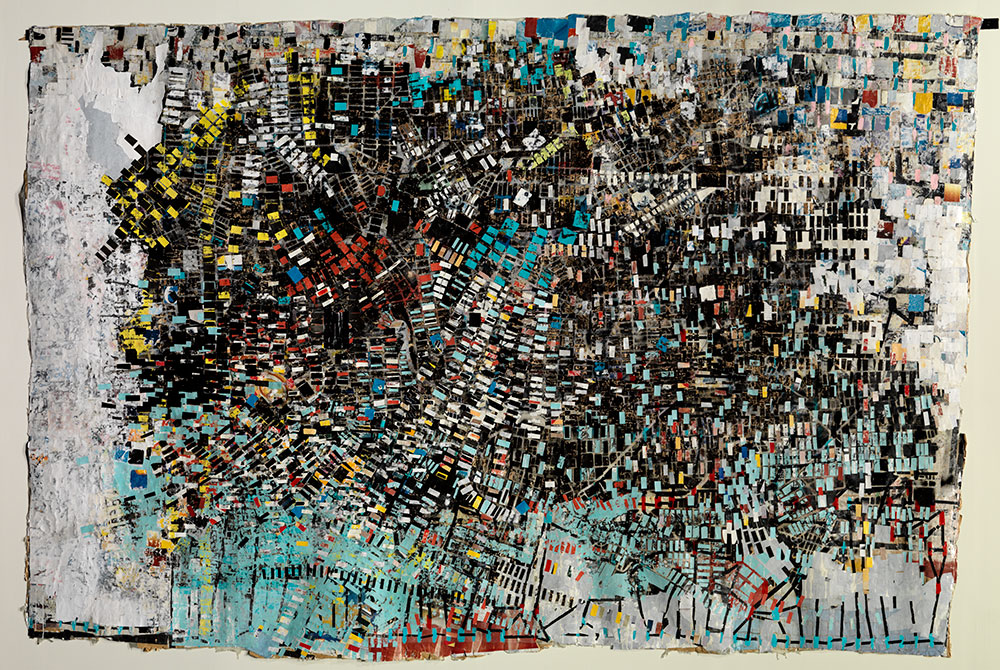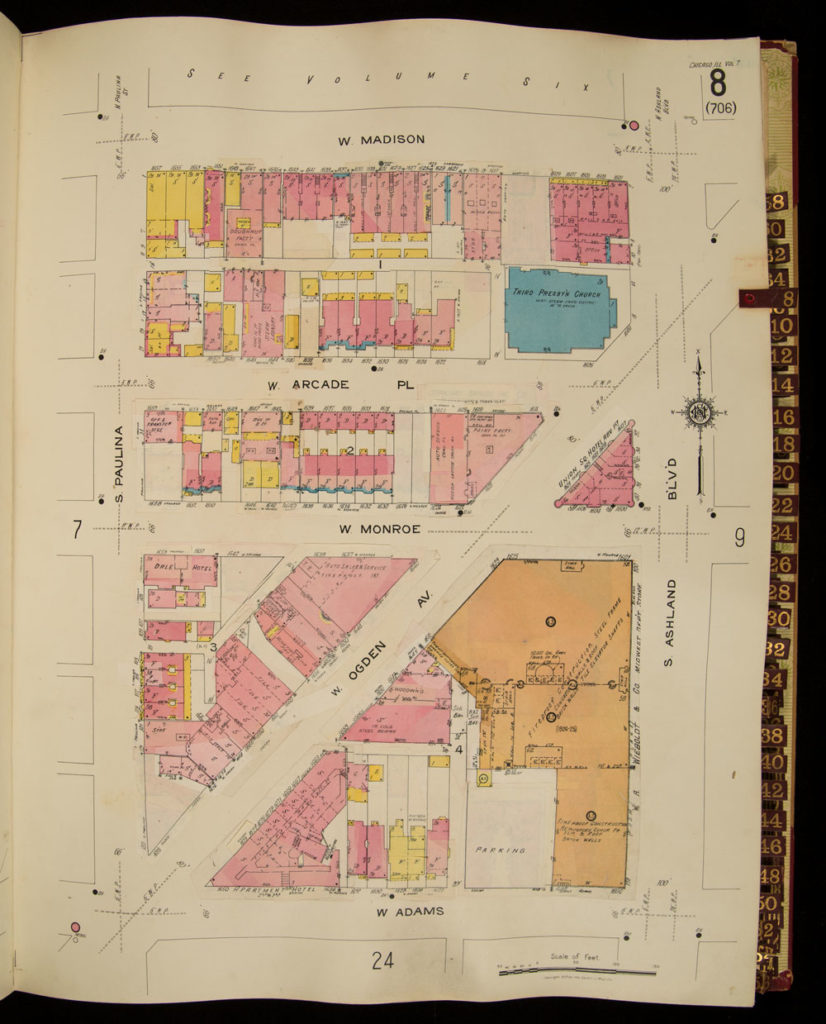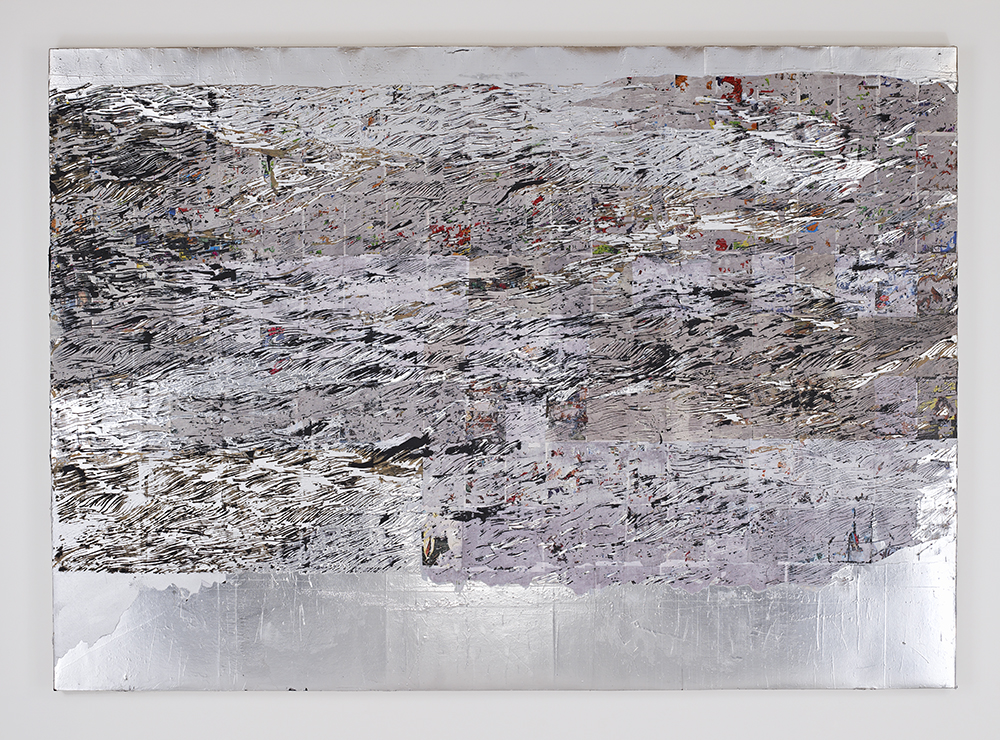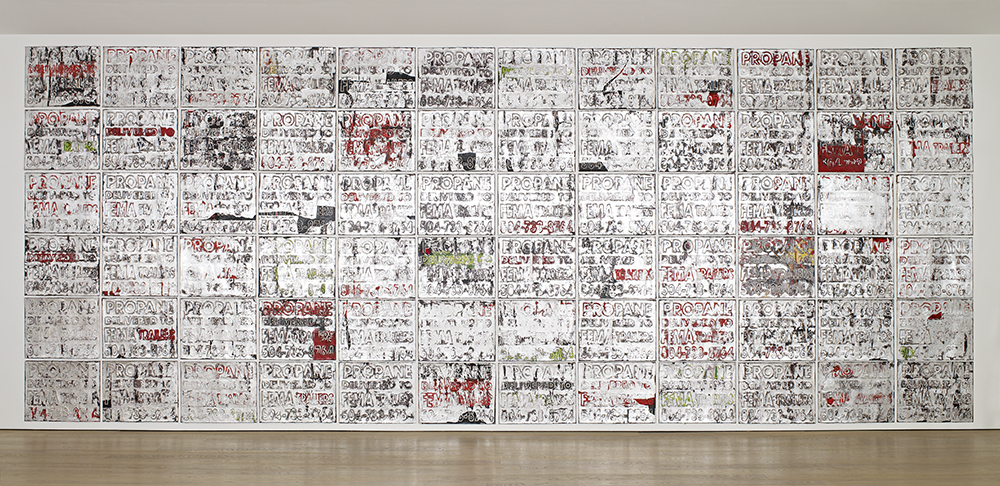John Vincler’s column “Brush Strokes” examines what is it that we can find in paintings in our increasingly digital world.

Mark Bradford, Black Venus, 2005. © Mark Bradford (courtesy the artist and Hauser & Wirth) Photo: Bruce White
Writing about art is often linked to the timely—the current exhibition, the just-released catalogue. The need for an immediate response makes fast what should be slow, and focusing on the continuously new can distort the experience of art. I want to attempt a subversion of this by thinking about the first time I saw the paintings of the Los Angeles-based artist Mark Bradford, now almost a decade ago. I want to revisit a moment before I thought I could write about art, to locate the moment when the looking deepened. There is a risk inherent in what I want to attempt here, primarily memory’s frailty: what have I forgotten and what have I embellished? My goal is to recollect not just the work of an artist but the moment when the way I thought about art changed.
In 2010, I was living in Akron, Ohio working in a library housed in the windowless basement of a converted department store, organizing a neglected rare book collection. My partner Kate and I had met in Chicago, eloped to London where I attended a one-year graduate program that would result in a decade worth of student loan debt, returned for a quick stint in Chicago then moved to Ohio. In London, I had gone to the free art museums regularly, especially the Tate. Once in Ohio, I often visited Akron’s excellent small art museum housed in a strangely radical contemporary building (a cantilevered postmodern glass and steel form embracing the central brick structure of Akron’s former central post office). The surprises in the permanent collection included Lee Bontecou, Yayoi Kusama, and Doris Salcedo. I began to travel regularly to continue my habit — to Detroit, Cleveland, and Pittsburgh, to museum and gallery shows. When I learned of a debut museum show of a young painter previously unknown to me at the Wexner Center for the Arts, two hours away in Columbus, Ohio, I made a plan to see it soon after the opening.
I can still remember entering the space of the Mark Bradford exhibition and making my way to the long sliver of a gallery. The gently sloped floor moved me slowly upward into the expanse of the Wexner’s exhibition space. And I remember being surprised by the scale of Bradford’s work (both the size of the canvases and the number of them). I remember that most of the works seemed oddly and immediately familiar, uncannily legible from the corner of my eye, or from across the room, but then vast and perplexing upon closer examination. The show consisted primarily of paintings… but were they? They seemed to be works of collage, but the surfaces were more unified than what I thought collage usually suggested. They were composed of paper, string, and…what?…paint, glue, or both, all congealed, dried, then sanded smooth? The most immediate visual association was to a common enough urban spectacle: layers of wheat-pasted posters or billboards with their surfaces torn so as to reveal the strata of layers, creating happenstance compositions. In Bradford’s work, wear and neglect were rendered as a technique, striking an alchemical balance between chance and design. The apparent method of composition suggested removal as much as addition: the surfaces seemed scored and sanded away. I remember looking at a painting in profile, examining the edges of the canvas to get a sense of the layers and thickness beneath the surface. Bradford’s paintings seemed excavated from within some earlier incarnation of themselves.
Why did Bradford’s paintings feel so familiar to me? I had never seen them reproduced before, and while various lineages could be traced (Jean Dubuffet’s scored and scratched surfaces, Glenn Ligon’s use of text as well as his sources, even Warhol’s serialized images and pop iconography), at that time I was unable to adequately trace them. His work was unlike anything I’d seen before. Wasn’t painting dead, anyway? Or so I had assumed before this show. But Bradford’s compositions seemed new, exciting even. The familiarity hit me partly because of the resemblance to torn posters but also because of his broadly legible forms. Take for example the near monochrome of Mississippi Gottdam (The title is a reference to Nina Simone’s civil rights anthem.) I still remember the first time I saw its surface of churning water, the marks seemingly incised in the live, roiling surface. The canvas is predominated by silver interrupted by staccato flows of mostly black and white, and spackled small flashes of various colors that are almost imperceptible at a distance. There was a sly play with scale, the huge canvas evoked smaller forms: water as depicted in an early European woodcut or perhaps a Japanese ukyio-e print. In the catalogue reproduction I am looking at now, I cannot make out the bits of color. But in person, on close inspection, I was able to see that the color came from comic book pages embedded in subdermal layers. There seemed to be such gravitas to the canvas and I found it disarming, almost funny, that the bits of green were from the Incredible Hulk.
Several paintings in the show were immediately recognizable as maps. These were my favorite of Bradford’s works both that first day and still. Patterned lines read as streets, rectangles suggest buildings, each spreading semi-organically and semi-architecturally—partly grown and partly built—across the surface of the paintings. An early painting in the show, Black Venus, from 2005, seems to render a bird’s eye view of a cityscape, the sort of view we are now accustomed to seeing displayed dynamically on our phones and screens in map and navigation apps. I may have been spending too much time in research libraries, but when I first saw these paintings that suggested cartography, I immediately thought of fire insurance maps from the mid-19th century to the early 20th century. These maps, called Sanborn Fire Insurance Maps are contained in giant atlases and document the footprints of individual buildings in major cities. Updates to the atlases were issued in sheets, which were intended to be cut out and pasted over the existing maps to bring them up to date. Over the years, the layers in the atlases would accrue, charting the buildup, alteration, and destruction of structures within a city. There seemed to be a link here between the pasted over billboard ads and the buildup and destruction of a city itself: the teeming activity, the churn of the new and the quick fade of consumerist gloss, the gentrification and the persistent poverty, ebbing and flowing.

Sanborn Map Company; Insurance maps of Chicago, Illinois, Volume 7, 1916. Courtesy of The Newberry Library, Chicago
*
After I had spent time with the paintings, I circled back to read the texts. There I learned that Mark Bradford’s work was informed by place, by the community of south Los Angeles where he grew up and still maintains his studio. He came to art making through working in his mother’s beauty shop (followed by an MFA at CalArts). Looking back now I wonder if I misread (or even noticed) “end papers” as a material used in Bradford’s early work. These were not the decorative pages at the beginning or end of a bound book, as I would have thought from my day-job myopia, but instead the “permanent-wave end papers,” used for protecting hair in his mother’s shop. Bradford repurposed them in his work—sometimes singeing the edges with flame—incorporating them alongside advertisements he pulled down from walls and fences in his neighborhood. The allusion to maps was intentional, and the incorporation of place more literal than I had at first imagined.
At the end of the exhibit space, I encountered Bradford’s 2008 painting The Corner of Desire and Piety (named after two parallel streets in the Ninth Ward of New Orleans). The sign “Propane delivered to FEMA trailers,” is followed by a phone number, in a repeated grid, in various stages of legibility. The signs are rendered as if they were relics unearthed from an archeological site, documenting the parasitism of capitalism upon catastrophe . After Hurricane Katrina, Bradford relocated temporarily to New Orleans, to listen, witness, and assist, but also to make work. I thought about the artist Paul Chan’s kindred project of restaging Waiting for Godot in the Lower Ninth Ward at about the same time. Chan and Bradford were marking an historic moment so that it wouldn’t be forgotten, paying witness through work that was engaged not just with an event, but a place, and a community. I’m not sure if this later work made me think back to Mississippi Gottdam then, but it should have made me reconsider my initial cursory reading. Mississippi Gottdam was an icon of destruction, closer to documenting the present than memorializing the past.
I didn’t think of any of the paintings as abstractions on that first visit—though I now know that Bradford situates his work as emerging from the abstract tradition, a tradition he took up in part because he felt it was closed off to him as a queer black artist. In an interview with the curator Hamza Walker, Bradford described some of his working methods: “I do draw, but then I go over the lines with another medium, or I go over the lines with string. That tracing removes the emotion from the gesture.” He describes his method of transformation, which is also a layering, “like drawing a place based on memory. And now we’re twice, three times removed. Like looking at a Google map based on a satellite image.” Perhaps in our looking then we attempt the inverse, an excavation of the distance between the artist, their work, and what we bring to it. Spending time with the paintings was like being let inside of something vast and previously unknown, not a space exactly, but a body of knowledge.
I would like to think that it was then, during that museum visit, that I began to think self-critically about the experience of seeing art. I realized if we can pause to consider works of art, a subtle excavation occurs: we sift through all of the associations and memories the work conjures, including the detritus and scraps of visual culture we carry within us. Maybe we begin to situate the work within the scope of art history as we understand it. And then we begin to sort through more critically looking for clues for how our associations may or may not sync with the artist’s intentions as far as they can be discerned (through titles, text, interviews, by comparing and contrasting the features and character of work brought together in an exhibition). We participate in what I now refer to as visual thinking: by attentive looking we consider how the artist has used material to embody thought or feeling and we attempt to move from our own experience more fully into the space of the artwork. For a time, we give ourselves over to it so that we may experience something new—an insight, a sensation, an experience—so that at least in some small way it may change us. What if another way of asking the question, “Is it art?” is ultimately personal and private: “Well, did it change you?”
Mark Bradford’s diptych “Duck Walk” (2016), is currently on view as part of the Met at Fifth Avenue’s exhibition Epic Abstraction.
John Vincler is a writer, visual artist, and has worked for a decade as a rare book librarian. He is editor for visual culture at Music & Literature and is at work on a book-length project on cloth as subject and medium in art.
from The Paris Review https://ift.tt/3342hQi


Comments
Post a Comment